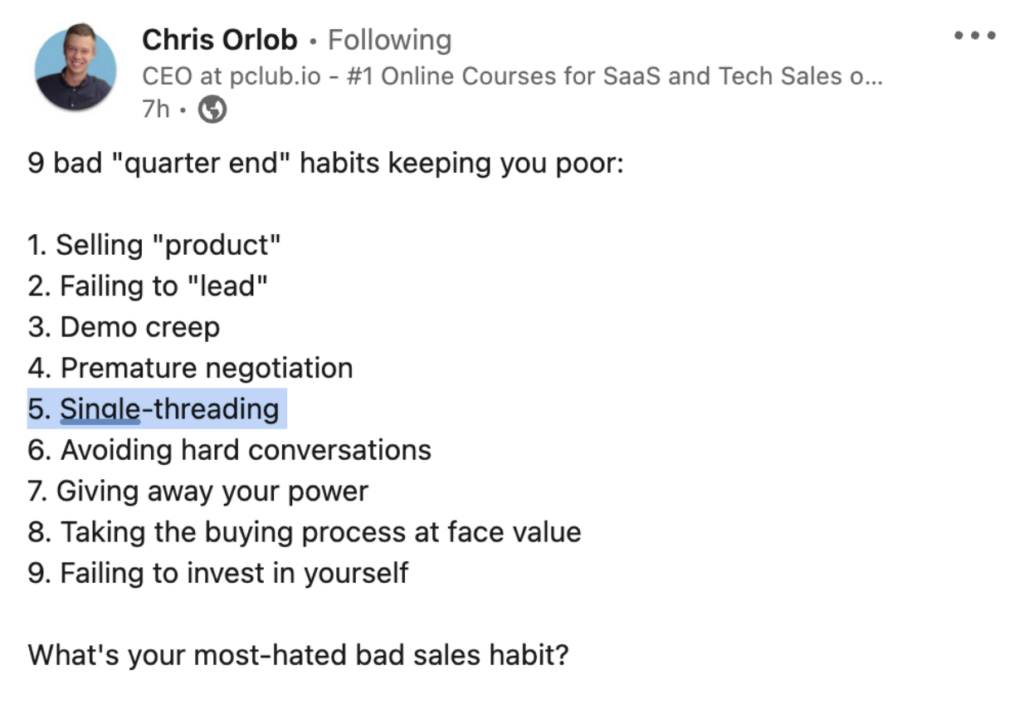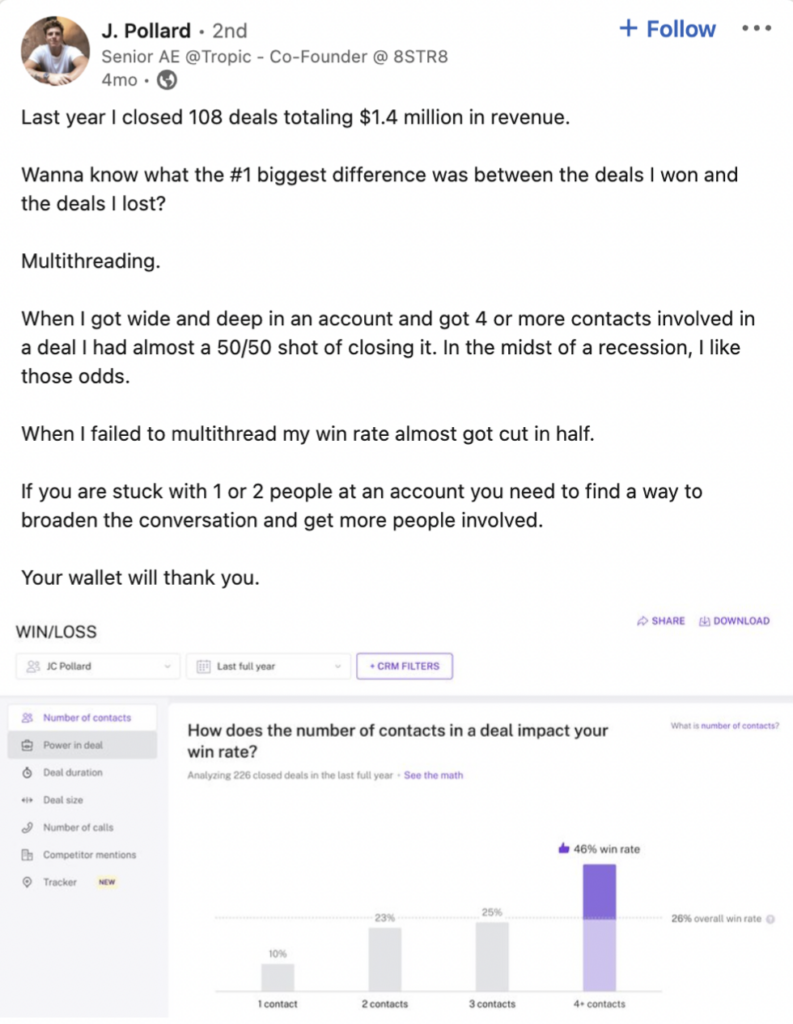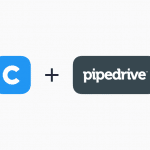Keep Win Rates Above 35% With Multithreading Sales Strategy

With multi-channel sales strategies becoming more and more popular, one could easily believe that using the traditional telephone to close deals won’t be effective in 2023.
But this couldn’t be further from the truth.
Sales calls, when done right, are still one of the most fruitful channels for winning new deals and keeping customer satisfaction high.
Each year, we reach out to countless people over the phone and see consistently high results. But the truth is we don’t just call people.
We have our own secret weapon – a method that many B2B companies still underutilize – that keeps our win rates consistently above 35%.
Keep reading to find out how we’re using a multithreaded sales strategy and how you can adapt it to your operations.
Key takeaways:
- Multithreading Sales Strategy Overview: Despite the prevalence of multi-channel sales, traditional telephone sales are still effective. A sales multithreading strategy is a key factor in maintaining win rates above 35%.
- Increase Win Rates with Multithreading: Aviso’s findings reveal a significant 42% increase in deal success by engaging with multiple decision-makers through the multithreading sales approach, offering advantages such as better handling of personalities, risk mitigation, and a swiffer sales process.
- Get Started with Multithreading: The transition from single-threaded approaches involves mapping out the prospect’s organization, identifying relevant roles, and employing genuine curiosity to understand broader organizational needs by incorporating additional stakeholders during conversations.
- Tackle Multithreading Challenges: To address common challenges like technology issues, disengagement, and setting the right tone, invest in reliable tools, encourage video calls, do thorough preparation, and communicate transparently about the sales call’s purpose.
Take selling a Step Further – Collaborative Selling: Pairing representatives with complementary skills gives you a competitive edge in high-stakes deals, ensuring the continuity of your operations in the evolving B2B sales landscape.
What is Multithreading?
Let’s kick off with a short definition. Multithreading is a strategic approach where sales professionals engage with multiple decision-makers within a prospective organization simultaneously.
Closing Deals with 20 Decision-Makers? The Number Keeps Growing
According to Gartner, the average number of stakeholders needed for closing B2B deals in 2015 was 6. By 2023, this number spiked up to eleven. And it’s not rare to see B2B purchases with over 20 decision-makers involved.
If not done correctly, having to go through so many people can be a real logistical nightmare – and a huge waste of time. You are risking miscommunication, misalignment, and inefficiency.
Instead of playing the Telephone game (pun intended) and single-threading your way through your prospect company, why not try sales multi-threading? This rarely adapted concept involves engaging with multiple decision-makers within a prospective organization.

Here is how we apply this method to keep our win rates high and our sales cycles short.
Increase Win Rate by 42% and Stay Focused with Multi-threading
According to Aviso, this approach increases the odds of winning a deal by 42%, compared to single-threading (engaging with only one contact).

Why Multi-threading Trumps Traditional 1:1 Selling
1. Multiple decision-makers: Engaging multiple stakeholders lets you effectively handle their individual personalities and prepare for unforeseen challenges.
2. Risk mitigation: Relying on one point of contact is risky. If they are out of office or go silent, your deal stalls. Multi-threading keeps the sales process moving.
3. Faster sales process: Aviso also observed that deals above $50K USD take 78 days fewer to close with multi-threading compared to single-threading. Even smaller deals can reduce your sales cycle time by 53 days. Time is money.

Getting Started with Multi-threading
So, how do you transition from a single-threaded approach to multi-threading?
Begin by mapping out your prospect’s organization. Identify the departments or roles that might be affected by your solution.
During conversations with your current contact, pose the question, “Who else is impacted by this challenge you’re facing?”
Depending on their response, suggest a joint conversation, saying, “Based on what you shared with me, is it fair that we involve this person or these people in the next step?” It’s hard to say no to this — involving others is seen as a natural next-step in many negotiations.
It’s essential to approach this with genuine curiosity. You’re not just looking to increase your contact points for the sake of having a large number in your CRM. You are doing it to truly understand your prospects’ broader organizational needs.
Here are all necessarily steps compiled in a handy multithreading-transition guide:
- Map prospect’s organization: Begin by conducting a thorough analysis of the prospect’s organization to identify key departments and roles that could be impacted by your solution.
- Inquire about Additional Stakeholders: During conversations with your primary contact, proactively ask, “Who else is impacted by this challenge you’re facing?” This question helps uncover potential decision-makers and influencers within the organization.
- Propose Joint Conversations: Based on the information gathered, suggest joint conversations with relevant stakeholders. For instance, say, “Based on what you shared with me, is it fair that we involve this person or these people in the next step?” This approach positions involving others as a natural progression in the negotiation process.
- Leverage Genuine Curiosity: Approach sales multithreading with genuine curiosity about the prospect’s organizational dynamics. Emphasize that the goal is not merely to increase contact points for the sake of numbers in the CRM but to gain a deeper understanding of the prospect’s broader organizational needs.
- Document and Organize Contacts: Implement a systematic method for documenting and organizing contacts within your CRM. Categorize them by departments and roles to maintain a clear overview of your engagement across the prospect’s organization.
- Build Relationships Continuously: Cultivate relationships with each identified stakeholder over time. Regularly check in, share relevant insights, and tailor your communication to address individual concerns and priorities.
- Adapt Communication Styles: Recognize that different stakeholders may have diverse communication preferences. Adapt your communication styles to resonate with each decision-maker, ensuring effective engagement and understanding.
- Collaborate on Problem-Solving: Encourage collaborative problem-solving by involving relevant stakeholders in discussions about challenges and potential solutions. This approach not only strengthens relationships but also fosters a sense of shared ownership in the decision-making process.
By incorporating these tactics, you can seamlessly transition to a multithreading strategy. You’ll learn to better navigate the complex landscape of enterprise sales and ultimately increase the chances of successful deals.
Tackling Common Multi-threading Challenges: 77% of Decision Makers Prefer Video Calls Over Audio
Every effective strategy has its challenges, but with some expert advice, you can navigate common hurdles.
Technology Issues: The More, The Trickier
Problem: With more participants, you might experience lagging or voices overlapping.
Solution: Invest in reliable conferencing tools and test them before the call. E mail all participants about the meeting details and technological requirements in advance, and record the meeting so you can share with participants in case they drop out.
Nobody’s Paying Attention: Maintaining Engagement
Problem: With multiple participants, some might drift into passive listening or multitasking, becoming completely disengaged and failing to pay attention.
Solution: Encourage turning cameras on. McKinsey’s study shows that 77% of B2B decision-makers favour video over audio.
First Impressions Matter: Setting the Right Tone from the Start
Problem: Beginning a group call can be awkward or feel forced, leading to a disengaged audience.
Solution:
- Prepare for each call thoroughly, anticipating questions and objections.
- Start with a proper introduction. It not only humanizes you but sets the tone for the entire conversation.
- Do your research about the culture your stakeholders are from. While some countries find small talk a waste of time (Germany, we’re looking at you), other nations can’t imagine doing business without a few minutes of ice-breaking chat first. Guidelines can save you from awkward situations, but your best bet is to read the room at every moment.
- Don’t disguise the intent of the call in front of any of the participants. Be upfront about it being a sales call. Be sure to clarify the purpose of the meeting as quickly and clearly as possible.
The Qualification: Striking the Right Balance
Problem: Struggling to get valuable information from the prospect or overwhelming them with salesy talk.
Solution: Be genuinely curious. Approach the conversation as a chance to learn about them, not just to push your product. At all times, you should make sure that what you’re sharing with your meeting participants still offers real value to them.
Deciding the Next Steps: Clear Action Items Post-Call
Problem: After a successful group call, there’s confusion or ambiguity about the next steps.
Solution: Before concluding, summarize the key points discussed and outline clear next steps. Assign responsibilities if necessary.
Taking It a Step Further: Collaborative Selling
Will Barron, a host of The Salesman.org podcast, suggests that you shouldn’t think about multi-threading just from the prospect company’s perspective. Keep multiple threads inside your own sales team as well. Let two or more salespeople with complementary skills jointly handle an account.
For example, you can pair a tech-savvy Gen Z representative with a seasoned veteran. Together, they can provide a diverse sales approach that clicks with stakeholders of all ages.
Besides, having multiple sales reps on board also ensures that if one of them isn’t available for any reason, the sales cycle doesn’t get prolonged and the prospect doesn’t get impatient.
This sales method is still a hidden gem, lacking data but may give you a competitive edge in high-stakes deals.
Wrapping up: Sales Calls Reimagined for Modern B2B Dynamics
As the landscape of B2B sales evolves, clinging to traditional methods can be a recipe for stagnation. Today, decision-making is a collaborative effort, involving multiple stakeholders with varied viewpoints and requirements. To address this, multi-threading presents a proven strategy, casting a wider net and deepening engagements and understanding.

Furthermore, the innovative approach of collaborative selling magnifies the potential of multi-threading. By incorporating diverse sales perspectives, we can cater to an even broader spectrum of client needs.
So, embrace multi-threading, delve into collaborative selling, and watch as your win rates soar.
FAQ
What is multithreading in sales?
Multithreading in sales refers to a strategic approach where sales professionals simultaneously engage with multiple decision makers within a prospective organization. Unlike traditional single-threaded methods, this approach involves building connections and relationships with various stakeholders, addressing individual personalities, and mitigating risks associated with relying on a single point of contact. The goal is to increase win rates, and expedite the sales process. It also enhances overall efficiency by navigating the complexities of modern B2B deals involving numerous decision-makers.
What is single-threading in sales?
Single-threading in sales refers to a traditional approach where sales professionals primarily engage with one key decision-maker or point of contact within a prospective organization. This method involves focusing on a linear, one-to-one communication strategy, often relying on a sole individual to navigate the sales process. While straightforward, single-threaded sales may pose challenges, such as the risk of communication breakdowns if the designated contact is unavailable or encounters delays, potentially leading to prolonged sales cycles and decreased efficiency.
How do you multithread in enterprise sales?
To multithread in enterprise sales, start by mapping out the prospect’s organization and identifying relevant departments or roles affected by your solution. During conversations with your primary contact, inquire about other stakeholders involved and propose joint conversations with them to broaden engagement.
What is multithreading in customer success?
Multithreading in customer success involves managing and nurturing relationships with multiple stakeholders within a client organization concurrently. Rather than relying on a single-threaded approach focused on one primary contact, this strategy acknowledges and engages with various decision-makers and influencers who play key roles in the success of a customer’s experience. The aim is to deepen connections, address diverse perspectives, and ensure a holistic understanding of the client’s needs. It ultimately contributes to a more comprehensive and effective customer success strategy.
How does multithreading differ from single-threading?
Multithreading allows for a more nuanced approach that addresses diverse personalities and eliminates issues connected to a single contact. This strategic method increases the odds of winning deals by 42%, expedite the sales process, and provide a more comprehensive understanding of client needs compared to the traditional single-threading approach. Single-threading relies on a linear, one-to-one communication strategy with a primary contact.




















